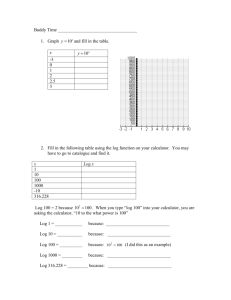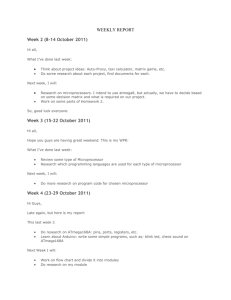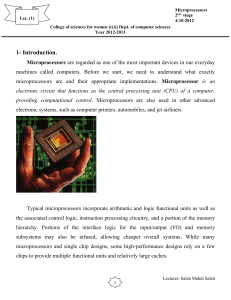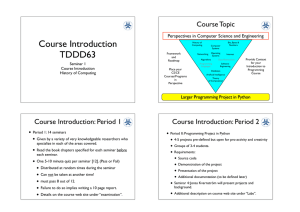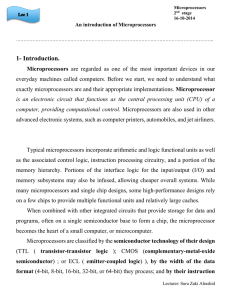Chapter 2
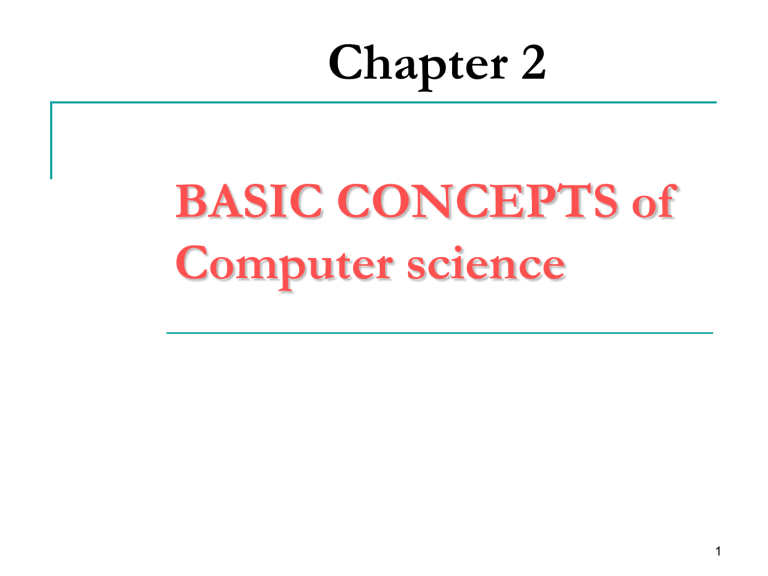
Chapter 2
BASIC CONCEPTS of
Computer science
1
1.1 OBJECTIVES
define a computer
identify characteristics of computer know the origin and evolution of computer
identify capability of computer in terms of speed and accuracy
distinguish computer from human beings and calculator
appreciate the evolution of computer through five generations
2
1.2 WHAT IS A COMPUTER?
Computer is an electronic device which capable of solving problems and manipulating data.
Computer can be defined in terms of its functions.
It can
i) accept data.
ii) store data. iii) process data as desired by doing some mathematical and logical operations. iv) retrieve the stored data as and when required.
v) print the result in desired format.
3
1.3
CHARACTERISTICS OF
COMPUTER
1- Speed
Computer can work very fast .
Computer can perform millions of instructions and even more per second.
6
The speed of computer in terms of microsecond (10 part of second) or nanosecond (10 -9 part of a second).
The speed of microprocessors , called the clock speed , is measured in megahertz.
A microprocessor that runs at 200 MHz executes
200 million cycles per second .
4
2- Accuracy
The degree of accuracy of computer is very high and every calculation is performed with the same accuracy.
The accuracy level is determined on the basis of design of computer.
The errors in computer are due to human and inaccurate data.
3- Diligence
A computer is a lack of concentration.
It can work for hours without creating any error
Due to this capability it overpowers human being in routine type of work.
5
4- Versatility
It means the capacity to perform completely different type of work.
5-Power of Remembering
Any amount of information can be stored in computer and recalled as long as you require it, for any numbers of years.
It depends entirely upon you how much data you want to store in a computer and when to lose or retrieve these data.
6
6- No IQ ( intelligence quotient)
Computer is a dumb machine and it cannot do any work without instruction from the user and it cannot take its own decision as you can .
7- No Feeling
It does not have feelings , it does not get tired even after long hours of work.
8- Storage
The Computer has an in-built memory where it can store a large amount of data.
You can also store data in secondary storage devices such as floppies, CDs Flash Memory which can be kept outside your computer and can be carried to other computers.
7
1.4 HISTORY OF COMPUTER
1-Calculating Machines
The first calculating device called ABACUS was developed by the Egyptian and Chinese people.
2Napier’s bones
Fig. 1.2: Abacus Computer
English mathematician
John Napier built a mechanical device for the purpose of multiplication
8
3 -Slide Rule English mathematician
Edmund Gunter developed the slide rule.
This machine could perform operations like addition, subtraction, multiplication, and division. It was widely used in Europe in 16th century.
4- Pascal's Machine a machine consisted of wheels, gears and cylinders , that could add and subtract .
5-Leibniz ’s Multiplication and
Dividing Machine it could both multiply and divide
9
6- Babbage ’s Analytical Engine
Charles Babbage (father of computer) built a mechanical machine to do complex mathematical calculations.
7-Mechanical and Electrical Calculator mechanical calculator was developed to perform all sorts of mathematical calculations. Later mechanical calculator was developed to the electrical calculator.
8-Modern Electronic Calculator at first made quite bulky then transistors.
It can do all kinds of mathematical computations and store some data permanently.
It is size too small.
10
1.5 COMPUTER GENERATIONS
1-First Generation Computers
First generation computers used Thermion valves.
These computers were large in size and writing programs on them was difficult.
Some of the computers of this generation were:
ENIAC : It was named Electronic Numerical Integrator And
Calculator (ENIAC). Today your favorite computer is many times as powerful as ENIAC, still size is very small.
EDVAC: It stands for Electronic Discrete Variable Automatic
Computer and was developed in 1950. The advantages is storing and doing logical decision internally.
Other Important Computers of First Generation :
EDSAC: ( Electronic Delay Storage Automatic Computer )
UNIVAC-1 .
11
Limitations of First Generation Computer:
Some drawbacks of first generation of computers:
The operating speed was quite slow.
Power consumption was very high.
It required large space for installation.
The programming capability was quite low.
12
2-Second Generation Computers
Around 1955 a device called Transistor replaced the bulky electric tubes in the first generation computer.
They have no filament and require no heating.
Manufacturing cost was also very low. Thus the size of the computer got reduced considerably.
It is in the second generation that the concept of Central
Processing Unit (CPU), memory, programming language and input and output units were developed. The programming languages such as COBOL, FORTRAN were developed during this period .
Some of the computers of the Second Generation were:
IBM 1620
: Its size was smaller as compared to First Generation computers and mostly used for scientific purpose.
IBM 1401
: Its size was small to medium and used for business applications.
CDC 3600
: Its size was large and is used for scientific purposes.
13
3 Third Generation Computers was introduced in 1964. They used Integrated
Circuits (ICs). Some of the computers developed during this period were: IBM-
360, ICL-1900, IBM-370, and VAX-750.
Higher level language such as BASIC was developed during this period.
Computers of this generations were small in size, low cost, large memory and processing speed is very high.
14
4-Fourth Generation Computers ( present day computers) . It uses large scale Integrated
Circuits (LSIC) built on a single silicon chip called microprocessors. Due to the development of microprocessor it is possible to place computer ’s central processing unit (CPU) on single chip. These computers are called microcomputers .
5-Fifth Generation Computer was introduced in 1990s . The speed is extremely high and it can perform parallel processing . The concept of Artificial intelligence has been introduced to allow the computer to take its own decision. It is still in a developmental stage.
15
1.7 TYPES OF COMPUTERS
1-Microcomputer.
2-Mini Computer .
3-Mainframes.
4-Supercomputer.
16
*
Microcomputers
:
Microcomputer is at the lowest end of the computer range in terms of speed and storage capacity. Its CPU is a microprocessor. The most common application of personal computers (PC) is in this category. The PC supports a number of input and output devices. Examples of microcomputer are IBM PC, PC-AT
17
*
Mini Computer
:
The mini computer is used in multiuser system in which various users can work at the same time. This type of computer is generally used for processing large volume of data in an organization. They are also used as servers in Local Area Networks (LAN).
18
*
Mainframes
:
These types of computers are generally 32bit microprocessors. They operate at very high speed, have very large storage capacity and can handle the work load of many users.
They are generally used in centralized databases. They are also used as controlling nodes in Wide Area Networks (WAN).
Example of mainframes are DEC, ICL and
IBM 3000 series.
19
*
Supercomputer
:
They are the fastest and most expensive machines. They have high processing speed compared to other computers. They have also multiprocessing technique. One of the ways in which supercomputers are built is by interconnecting hundreds of microprocessors.
20
Supercomputers are mainly being used for whether forecasting, biomedical research, remote sensing, aircraft design and other areas of science and technology. Examples of supercomputers are CRAY YMP,
CRAY2, NEC SX-3, CRAY XMP and
PARAM from India.
21






